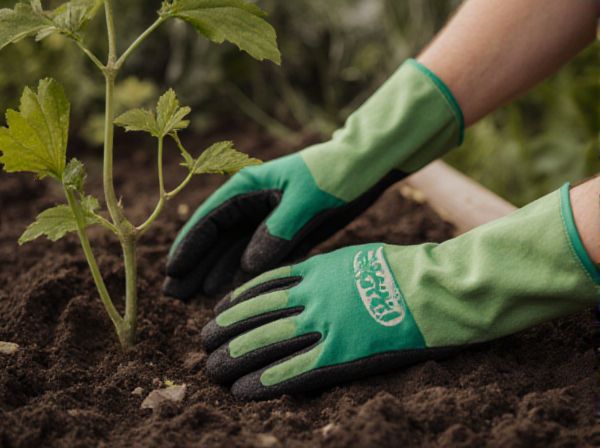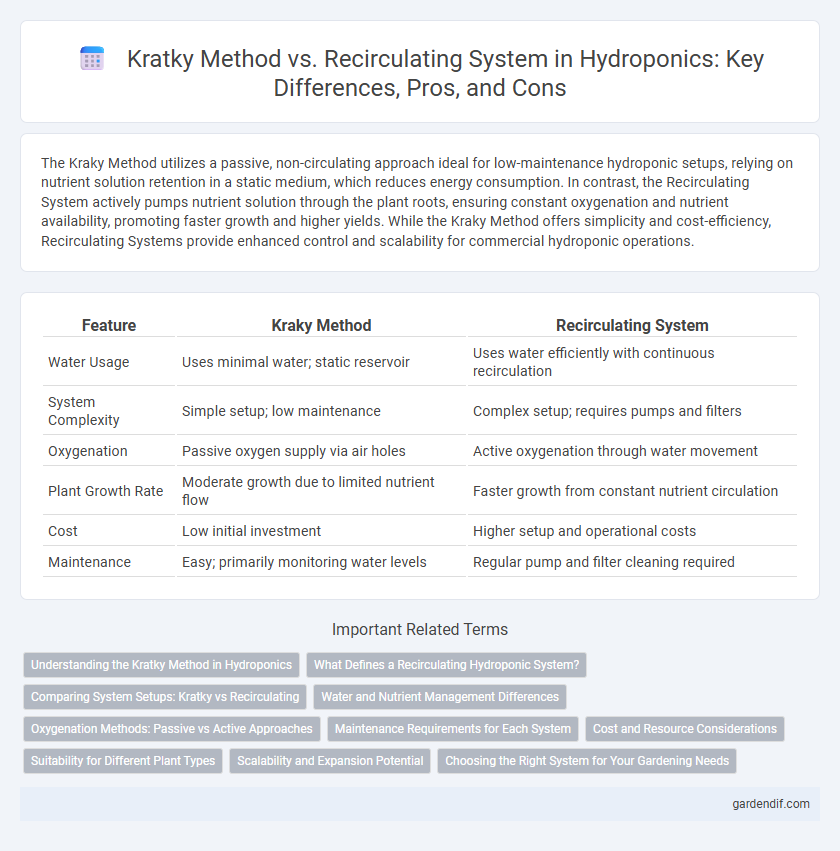
Kraky Method vs Recirculating System Illustration
The Kraky Method utilizes a passive, non-circulating approach ideal for low-maintenance hydroponic setups, relying on nutrient solution retention in a static medium, which reduces energy consumption. In contrast, the Recirculating System actively pumps nutrient solution through the plant roots, ensuring constant oxygenation and nutrient availability, promoting faster growth and higher yields. While the Kraky Method offers simplicity and cost-efficiency, Recirculating Systems provide enhanced control and scalability for commercial hydroponic operations.
Table of Comparison
| Feature | Kraky Method | Recirculating System |
|---|---|---|
| Water Usage | Uses minimal water; static reservoir | Uses water efficiently with continuous recirculation |
| System Complexity | Simple setup; low maintenance | Complex setup; requires pumps and filters |
| Oxygenation | Passive oxygen supply via air holes | Active oxygenation through water movement |
| Plant Growth Rate | Moderate growth due to limited nutrient flow | Faster growth from constant nutrient circulation |
| Cost | Low initial investment | Higher setup and operational costs |
| Maintenance | Easy; primarily monitoring water levels | Regular pump and filter cleaning required |
Understanding the Kratky Method in Hydroponics
The Kratky Method in hydroponics is a passive, non-circulating system that relies on a static nutrient solution, making it highly water-efficient and low-maintenance compared to recirculating systems. Unlike recirculating hydroponics, which uses pumps to continuously move nutrient solutions, the Kratky Method allows plants to access air as the water level decreases, promoting oxygen absorption at the roots. This method is ideal for small-scale or beginner growers seeking a simple, cost-effective way to cultivate leafy greens without the complexity of aeration or circulation equipment.
What Defines a Recirculating Hydroponic System?
A recirculating hydroponic system continuously cycles nutrient-rich water through plant roots, optimizing resource efficiency and minimizing water waste. This method contrasts with the Kratky method, which is a passive, non-recirculating technique relying on a stagnant nutrient solution and air gap for root oxygenation. Recirculating systems maintain precise control over nutrient delivery and environmental conditions, enhancing plant growth rates and yield consistency.
Comparing System Setups: Kratky vs Recirculating
The Kratky method employs a passive, non-circulating setup that requires no pumps or aerators, where plants grow suspended above a nutrient solution with roots gradually reaching down as the water level decreases. In contrast, the Recirculating system utilizes active components such as pumps and aeration to continuously move nutrient solution, maintaining oxygen levels and nutrient balance for faster plant growth. The simplicity and low maintenance of the Kratky method suits small-scale or beginner hydroponics, while the Recirculating system supports larger-scale, intensive production with greater control over environmental variables.
Water and Nutrient Management Differences
The Kraky Method emphasizes a non-recirculating flow of water and nutrients, allowing continuous delivery of fresh nutrient solution to plants while minimizing the risk of pathogen buildup. In contrast, the Recirculating System reuses nutrient solution by cycling it back through the system, optimizing water efficiency but requiring careful monitoring to prevent nutrient imbalances and contamination. These differences impact nutrient concentration stability, water consumption rates, and overall system maintenance in hydroponic farming.
Oxygenation Methods: Passive vs Active Approaches
The Kratky Method utilizes passive oxygenation by relying on the air gap between the nutrient solution and plant roots, enabling oxygen intake without mechanical intervention. In contrast, recirculating hydroponic systems employ active oxygenation through air pumps and diffusers, ensuring continuous oxygen supply and nutrient circulation for optimal root respiration. Passive oxygenation methods reduce energy consumption and system complexity, while active approaches enhance growth rates by maintaining higher dissolved oxygen levels in the nutrient solution.
Maintenance Requirements for Each System
The Kraky Method demands minimal maintenance, involving routine checks to ensure water levels and nutrient solutions are balanced without complex mechanical parts. In contrast, the Recirculating System requires more intensive upkeep, including regular cleaning of pumps, filters, and tubing to prevent clogs and algae growth. Effective maintenance of the Recirculating System directly impacts water quality and plant health, making it more labor-intensive compared to the simpler Kraky Method.
Cost and Resource Considerations
The Kraky Method minimizes water usage and eliminates the need for pumps, resulting in lower initial capital costs and reduced energy consumption compared to Recirculating Systems. Recirculating Systems demand higher upfront investment for equipment like pumps and reservoirs but optimize nutrient recycling, reducing long-term water and fertilizer expenses. Cost-effectiveness hinges on scale and resource availability, with the Kraky Method favoring small-scale, low-resource setups and Recirculating Systems suited for larger, commercial operations.
Suitability for Different Plant Types
The Kraky Method excels in supporting leafy greens and herbs due to its simple nutrient delivery and low oxygenation levels. Recirculating systems offer greater versatility, accommodating fruiting plants and larger crops by precisely controlling nutrient concentration and oxygen levels. Plant root structures and growth rates are key factors in determining system suitability, with recirculating setups better suited for extensive root systems and higher nutrient demands.
Scalability and Expansion Potential
The Kraky Method offers a low-cost, small-scale hydroponic solution ideal for beginners and limited space, but it lacks flexibility for large-scale commercial expansion. In contrast, the Recirculating System is designed for scalability, enabling efficient nutrient reuse and easy integration with automated controls, making it suitable for expanding operations from small farms to industrial-level production. Its modular design supports incremental growth, optimizing resource management and operational efficiency in extensive hydroponic setups.
Choosing the Right System for Your Gardening Needs
The Kraky Method offers a simple, cost-effective hydroponic setup ideal for small-scale or beginner gardeners seeking easy maintenance and minimal equipment. Recirculating systems provide advanced nutrient control, water efficiency, and scalability, making them suitable for commercial growers or those aiming for higher yields. Assess available space, budget, and desired crop types to determine whether the streamlined Kraky Method or the efficient recirculating system aligns best with your hydroponic gardening goals.
Kraky Method vs Recirculating System Infographic

 gardendif.com
gardendif.com